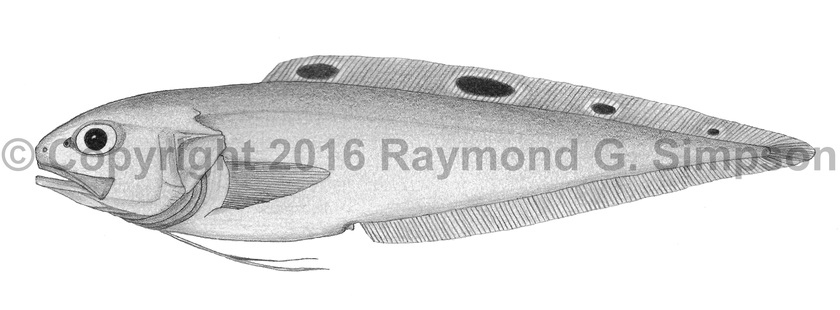
Common Name
Ocellated Brotula
Year Described
Günther, 1887
Identification
Dorsal Fin: 96-100
Anal Fin: 81-85
Pelvic Fin: 2
Pectoral Fin: 24-27
Caudal Fin: 7-8
Gill Rakers: 14-16 (only long rakers)
Pseudobranchial Filaments: 3-4
Vertebrae: 56-58
Body elongated and eel-like. Snout blunt. Jaw extends past posterior margin of orbit. Teeth present in jaws, on palatine, and on vomer. Antherior basibranchial tooth path narrow and long. Preopercular spines number 0-1. Spine on preopercle weak and thin in small fish but absent in large specimens. Opercular spine strong. Dorsal and anal fins confluent with caudal fin. Pelvic fin reaches 2/3 of the way to the anus. Lateral line not obvious. Body scales cycloid.
Color
Body brown above, grading to whitish on the belly. There are tiny melanophores sprinkled on the ventral body and the head. Gill region, gut, lips, and area around anus darker brown. Dorsal fin usually with two ocelli (sometimes one; rarely 3-4). The two dominant ocelli are on the anterior dorsal fin (covers 5-7 dorsal rays) and the one at midbody. A few smaller ocelli or spots can occur on the posterior half of the dorsal fin. Anal fin plain or with a few indistinct spots.
Size
Maximum size to 147mm SL.
Habitat
Occurs offshore from 233-641m.
Range
Known only from the coast of eastern Brazil (Pernambuco to Bahia).
References
Nielsen, J. G. 1999. A review of the genus Neobythites (Pisces, Ophidiidae) in the Atlantic, with three new species. Bulletin of Marine Science v. 64 (no. 2): 335-372.
Nielsen, J. G., F. Uiblein and M. M. Mincarone 2009. Ocellus-bearing Neobythites species (Teleostei: Ophidiidae) from the West Atlantic with decription of a new species. Zootaxa No. 2228: 57-68.
Other Notes
Best distinguished from the Caribbean Neobythites multiocellatus by the position of the first distinct ocellus near the front of the dorsal fin.